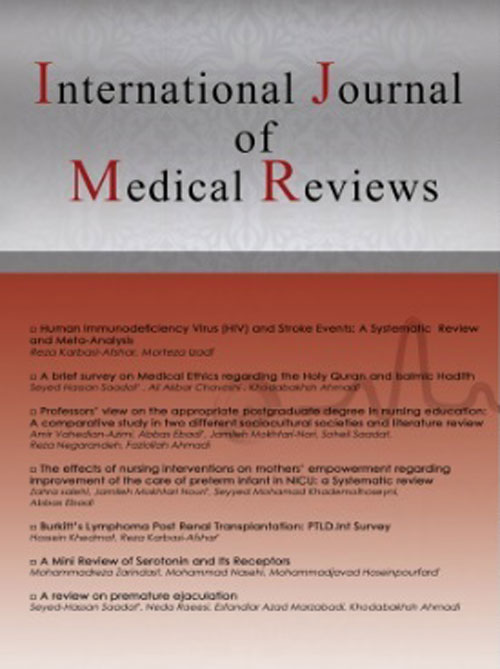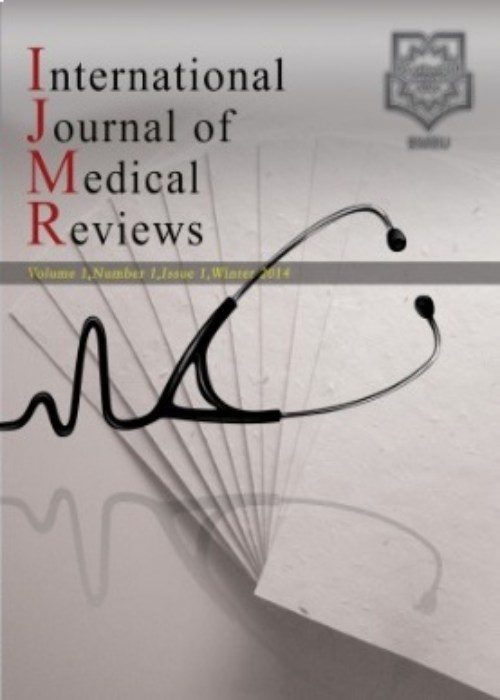فهرست مطالب

International Journal of Medical Reviews
Volume:2 Issue: 3, Summer 2015
- تاریخ انتشار: 1394/07/13
- تعداد عناوین: 7
-
Pages 257-259Health care systems are facing the challenge of caring for complex patients described by the presence of co-occurring and multiple chronic diseases that is known as multimorbidity (1-4). Multimorbidity has a relevant impact on patients'' outcomes in both younger and older adults and many of them are hospitalized in intensive care units (ICU) (1, 5-15).Approximately 10% of these patients die in ICU and 15% are expected to die in hospitals, and the vast majority of patients survive to hospital discharge (16).The understanding of short and long term physical and psychological morbidity associated with ICU survivorship, has led to an exploration and identification of both the precipitating factors and interventions which could reduce the incidence and severity of complications (14, 17-21). From one side, survivorship from the ICU has doubled from a mere 40% in 1990 up to 80% in 2010 (22-24), and from the other side, up to one third of the total mortality that occurs after a successful discharge (25). This high mortality rate after a successful discharge from the ICU emphasizes the critical need for additional attention to this complex decision-making process.Numerous follow-up studies have shown significant and long lasting physical and psychological dysfunctions in survivors of critical illness, all of which contribute to a reduced health-related quality of life (profound tiredness and weakness; pain; ongoing physical disability; sleeping difficulties; depression; irritability and post-traumatic stress (26), delays in optimal functional recovery for a significant percentage of survivors (14, 27, 28), an increased risk of death, length of stay, and higher costs (24, 29, 30). (14, 16, 27, 31-35).Research suggests that half or more of all adverse events following ICU discharge may be preventable with better standards of care (36). Furthermore, It is important for interventions aimed at improving their functional dependency, mortality, morbidity, and quality of life after hospital discharge (37). Afterwards, understanding the outcomes for patients who survive hospital after critical illness is important for patients and their family, the practitioners caring for these patients and health service providers who plan and provide essential heath care services (16). This is all due to the fact that it can have detrimental effects on day to day life and the ability of the patient to resume previous levels of activity before hospitalization (27). In this situation, a challenge which exists for the health care systems is to organize and provide care that is individualized and is focused on the whole person rather than on separate health issues (2, 38).A holistic approach could help researchers and clinicians to identify resources and barriers relevant to the management of similar and unique symptoms that cause problems in the everyday lives of patients (39).To the best of the researchers knowledge, to improve long term outcomes, many different ICU follow-up programs have been conducted for patients with long ICU length of stay or for those deemed in need (31, 32) in the United Kingdom (33, 40-43), Australia (19, 36, 44, 45), Italy (46), USA (23), Sweden (31, 32, 47-50), Denmark and Norway (34). Among the programs, Anna''s Psychological and psychical and Dorothy''s Psychological predictive screening models are more congruent with the Iranian context. Furthermore, the researchers think the models should be selected by relevant researchers in order to validate in the Iranian''s ICU discharge patients.
-
Pages 261-264Now a day some overused agents have influenced on cognitive neuroscience studies. Some of the brain structures that regulate and control our behaviors are from these aspects so one of these pathways has focused in this study. On the other hand human behavior such as perception, action, language, and emotion have more pay attention in cognitive neural science. In this review study data has gathered in a matrix that conformed by these aspects. It tries to find the frequency of current researches in any of these branches of the research matrix. Some of these researches locate in at least situation in frequency. Nucleus Accumbens (NA) and Hippocampus have discussed in this way. This study try to classify recent studies in reward system and then suggest the approach for following studies.Keywords: Reward system, neural pathway, dopaminergic pathway, hippocampus, ventral tegmental area, amygdala, nucleus accumbens, prefrontal cortex
-
Pages 265-271The first essential step to addressing disruptive behaviors is to gain an understanding of the causes of disruptive behaviors in healthcare organizations. This review article was conducted to gain an understanding of the causes of disruptive behaviors in the nursing workforce. The University of York center for Reviewers and Dissemination Guidance approach was used for searching five databases (PubMed, PsycINFO, CINAHL, Medline and Science direct) with 3main category key words from 2000 to Nov 2014. Lastly, 12 full texts were analyzed for responding to the research question. The results are explained in four categories; individual, organizational, environmental and social factors. This study showed that disruptive behaviors are a complex phenomenon, and the causes that contribute to disruptive behaviors typically operate at multiple levels and suggested that there are many factors behind a disruptive behavior and the escalation of the situation.Keywords: Causes, Disruptive behaviors, Nursing workforce, Systematic review
-
Pages 273-277IntroductionNursing education are expected to prepare qualified professionals who are capable of identifying individual and collective health needs in the epidemiological transition societies and providing care using the best scientific evidence. Continuous creative teaching strategies after graduation can be the key to combine basic training and professional practice. This scoping review examines different evidence-based approaches nursing education.MethodsThe review covers the period of 2007-2013. Searches were done initially by single keywords and using OR/AND, for combining words such as: evidence-based education, teaching methods, evidence-based nursing education, teaching strategies for identify publications from SID, IRANMEDEX, MAGIRAN, OVID, PROQUET, CINAHL, and PubMed databases. A total of 684 publications were found, from which, after excluding duplication and non-related papers, only nine publications were considered relevant to the subject and examined in-depth.ResultsFive teaching strategies of the evidence-based approaches were identified. They included: special settings and specific curriculum, collaborative approaches with clinical nurses, virtual teaching, interactive methods in small groups and project-based educational approach.ConclusionNursing educational strategies of evidence-based approaches vary with regards to content and implementation strategies. Different teaching techniques have been tried with different degree of success. It is the responsibility of the academic institutions and policy-makers to promote evidence-based teaching to reduce the gap between science production and clinical care.Keywords: Evidence, based Approach, Teaching Strategies, Nursing Education
-
Pages 279-286IntroductionAssessment and measurement of anger have been an interesting subject for experts in psychological and social sciences and have been done in varied forms especially in three different populations of ordinary, clinical, and military clusters.MethodIn the present systematic review, keywords include “anger assessment, anger measurement, anger assessment instruments, standardization of anger assessment instruments, standardization of anger measurement instruments, and anger test”. These keywords were searched in “PubMed, ScienceDirect, Google Scholar, Google Patent, MagIran, SID, Proquest, Ebsco, Springer, IEEE, Kolwer, & IranDoc” search engines. According to the relation between the study sections, academic publishing, publishing after 2000 and Jadad system relevant sources were selected. The manuscripts were then finalized by the evaluation of five experts in anger domain via the Delphi method.ResultsAccording to analyses of ordinary, clinical, and military populations, four specific and three general-purpose instruments of anger assessment have been found which have at least more than three studies of standardization and validation.ConclusionAccording to the study findings, it is proposed to validate, and standardize NAS-PI in different populations in order to anger assessment and investigation in healthy and non-clinical, clinical and pathological, as well as military populations. The lack of biological and physiological anger assessment instruments is discussed as well.Keywords: Anger, Anger Assessment, Anger Measurement, Systematic Review, Jadad Method, Delphi Method
-
Pages 287-290IntroductionTaking and recording of medical – pharmacological histories of patients before dental procedures by dentists are extremely important and should be considered as a duty. This study aims to determine the importance، benefits، and aims of assessing the medical history in dental patients.MethodsThis study was a narrative review which reviewed the studies published between 1980 and 2015 by using an electronic، academic and scientific resource approach with the following key words، including: Medical history، Dentistry، Patient، Aims and Benefits. At the end، the collected data were simply content analyzed.ResultsIn this study، 12 important and practical aims were identified in patients’ history، as follows: 1) Achieving a correct diagnosis، 2) Communicating with the patient، 3) Informing the patient، 4) Planning treatment، 5) Determining appropriate prognosis، 6) Managing the patient، 7) Keeping data، 8) Attaining communication between doctor and dentist، 9) Discovering preventive factors، 10) Preparing legal documentation، 11) Developing clinical studies، and 12) Providing educational programs.Conclusiongetting to know the patients means having more control on the patient and the disease and is the basis of making the right decisions and designing prevention and definite treatments، which have important benefits for both the physician and the patient.Keywords: Dentistry, Patient, Medical history, Aims, Benefits
-
Pages 291-295In review of medical education literature there are seven main categories of learning theories. This review has aimed to summarize them. Different learning theories include adult learning theories (Andragogy), behaviors orientation, cognitivist orientation, humanist orientation, social learning orientation, constructivist model and transformation learning. In conclusion, in medical education and its theories bases should effectively include all of these aspects in order to train competent graduates.Keywords: Learning Theories, Medical Education, Review


